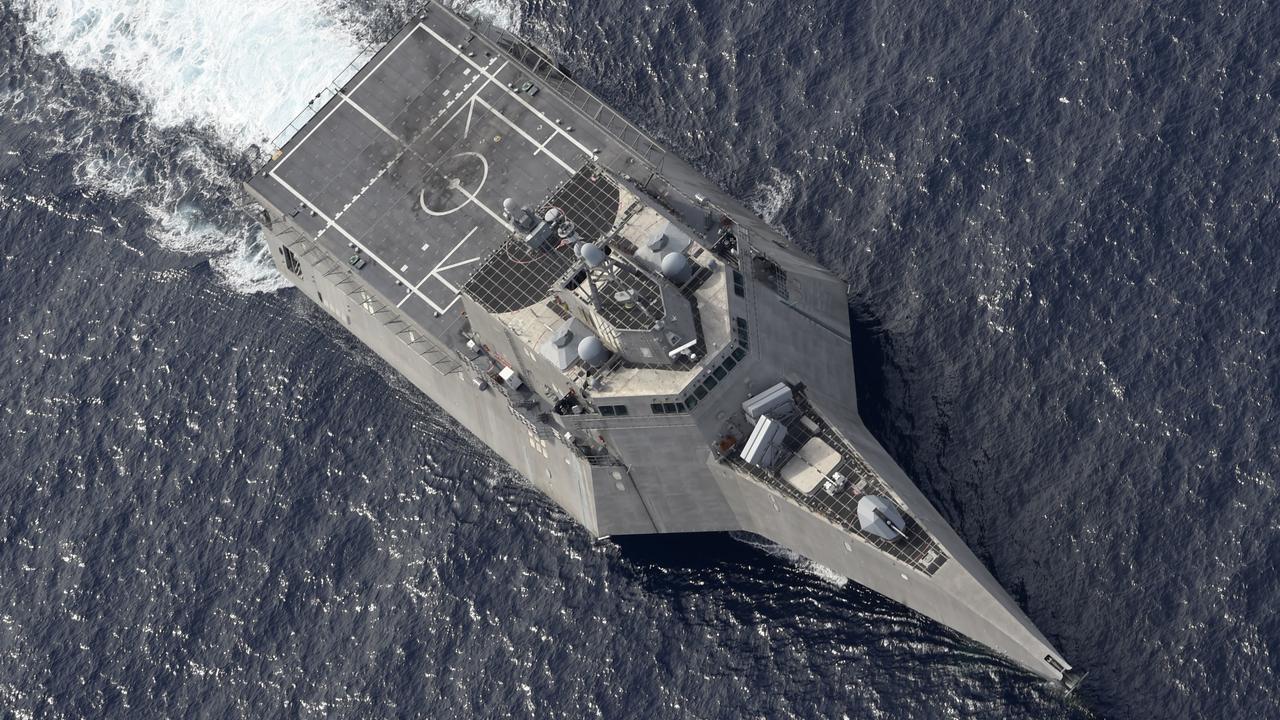‘Threat’: Hostile US-China stand-off
China has been flexing its muscles over the South China Sea and the US has now done the one thing Beijing warned them not to.
What a difference a week makes. A month ago, US and British Carriers crossed the South China Sea to little fanfare. Last week, Beijing suddenly demanded all foreign warships “register” their intent to enter the international waterway. This week, the US did what it’s always done. But Beijing’s crying foul.
“The Chinese People’s Liberation Army (PLA) Southern Theater Command on Wednesday vowed to stay on high alert and safeguard China’s sovereignty and security, and protect peace and stability in the South China Sea,” the Communist Party-controlled Global Times declares.
But China has no sovereignty there. At least none that the US, Vietnam, Malaysia, Taiwan and the Philippines accept.
It built a series of artificial island fortresses atop what were once tidal reefs in the Spratly and Paracel Islands. Under the United Nations Convention on the Law of the Sea (UNCLOS), tidal reefs, rocks and sandbars don’t count as territory. Nor do artificial islands.
Beijing says they do.
On September 1, China upped the ante by demanding that any vessel that “poses a threat” to China register its presence, intent, and nature when seeking to enter its “territorial” waters.
To Beijing, that includes the entire South China Sea. So Washington pushed back.
It sent in the USS Carl Vinson aircraft carrier and its task force – without completing the requisite paperwork. It’s also conducted one of its most assertive “freedom of navigation” exercises yet.
The trolls roar
“Hopefully when Chinese warships pass through the Caribbean Sea or show up near Hawaii and Guam one day, the US will uphold the same standard of freedom of navigation. That day will come soon,” tweeted the Communist Party-controlled Global Times editor-in-chief, Hu Xijin.
It’s an argument of false equivalence. The devil is in the detail. That detail is “the same standard”.
Washington does not claim the Caribbean Sea. Its ownership isn’t disputed. Hawaii is a permanent above-water feature and not an artificial island. Its ownership isn’t disputed.
The US Navy’s Twitter account responded by posting examples of Chinese naval vessels freely passing through the 12 nautical mile territorial waters of Guam and Hawaii – all allowed under UN-defined ‘innocent passage’ rules.
Washington argues it applies its interpretation of UNCLOS standards to all unconfirmed claimants – be they Vietnam, Taiwan, the Philippines – or China. It recently upset its Quad ally India by conducting a similar FONOP passage in its disputed waters.
“All nations, large and small, should be secure in their sovereignty, free from coercion, and able to pursue economic growth consistent with accepted international rules and norms,” a US Navy statement reads.
Border brinkmanship
On Wednesday, the United States sent a guided-missile destroyer, the USS Benfold, on a risky mission. It passed within 12 nautical miles (22km) of a heavily armed Chinese artificial island fortress – Mischief Reef – in the Spratly Islands.
Beijing points to the manoeuvre as “ironclad proof of US’ navigation hegemony and militarization of the South China Sea”.
The USS Benfold’s transit had “unlawfully entered the waters off Meiji Jiao (Mischief Reef) without permission from the Chinese government,” a People’s Liberation Army statement reads.
“More and more facts have proved that the US is the biggest risk maker and the biggest breaker of stability and peace in the region,” Air Force Senior Colonel Tian Junli reportedly said.
He stressed, “China has sovereignty over the islands and nearby waters, and the troops of the PLA Southern Theater Command will stay on high alert”.
Washington says it doesn’t care who owns the Spratly Islands, so long as UN law is used to resolve that disputed ownership. It also says it only accepts the UN’s definition of what constitutes national territory.
Which is why it doesn’t accept Beijing’s claim. Nor does it accept that artificial islands impart sovereignty.
In its natural state, Mischief Reef is underwater at high tide. It’s just one of several atolls Beijing has dredged and raised before adding airfields, barracks, military-grade docks, radars and weapons towers.
Washington’s not a signatory to UNCLOS. Beijing is. Which is why calling the destroyer’s transit a “serious violation of China’s sovereignty and security” makes little sense.
Sabre rattling
The USS Carl Vinson crossed through the narrow Bashi Channel between Taiwan and the Philippines on Monday, September 6. This was six days after Beijing issued its new law. Chinese analysts say it was the sixth time a US aircraft carrier had entered the South China Sea this year.
It was greeted with the usual hostility. First, one of its escorting P-8A Poseidon anti-submarine aircraft was challenged outside Taiwan airspace by Chinese fighters. Then a flight of four H-6K bombers (capable of carrying “carrier killer” missiles) entered the area.
“The troops will firmly perform their duties and missions to safeguard China’s sovereignty and security, and protect peace and stability in the South China Sea,” Colonel Tian states.
On Thursday, China’s Southern Theater Command issued a statement claiming it had “followed, monitored, warned and expelled” the US destroyer.
Again, Washington disagrees.
“The PRC’s statement about this mission is false,” a terse US Navy statement replied.
“The operation reflects our commitment to uphold freedom of navigation and lawful uses of the sea as a principle. The United States will continue to fly, sail, and operate wherever international law allows, as USS Benfold did here. Nothing PRC says otherwise will deter us.”
The US Navy argues its ships are exercising their rights by merely passing by. They have no intention of remaining in contested waters, it insists. So when they leave, they do so under their own will.
“The PLA(N)’s statement is the latest in a long string of PRC actions to misrepresent lawful US maritime operations and assert its excessive and illegitimate maritime claims at the expense of its Southeast Asian neighbours in the South China Sea.”
For all the latest Technology News Click Here

